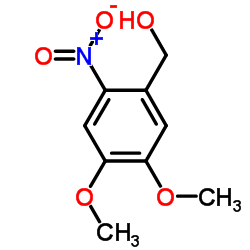(4,5-Dimethoxy-2-nitrophenyl)methanol

(4,5-Dimethoxy-2-nitrophenyl)methanol structure
|
Common Name | (4,5-Dimethoxy-2-nitrophenyl)methanol | ||
|---|---|---|---|---|
| CAS Number | 1016-58-6 | Molecular Weight | 213.187 | |
| Density | 1.3±0.1 g/cm3 | Boiling Point | 383.9±37.0 °C at 760 mmHg | |
| Molecular Formula | C9H11NO5 | Melting Point | 145-148 °C(lit.) | |
| MSDS | Chinese USA | Flash Point | 186.0±26.5 °C | |
|
Photocontrol of protein activity in cultured cells and zebrafish with one- and two-photon illumination.
ChemBioChem. 11(5) , 653-63, (2010) We have implemented a noninvasive optical method for the fast control of protein activity in a live zebrafish embryo. It relies on releasing a protein fused to a modified estrogen receptor ligand binding domain from its complex with cytoplasmic chaperones, up... |
|
|
Nitration of veratryl alcohol by lignin peroxidase and tetranitromethane.
Arch. Biochem. Biophys. 352(1) , 121-9, (1998) Lignin peroxidase (LiP), from Phanerochaete chrysosporium, in the presence of H2O2 and tetranitromethane (TNM), oxidizes veratryl (3,4-dimethoxybenzyl) alcohol (VA) (I) to veratraldehyde (IV), 4,5-dimethoxy-2-nitrobenzyl alcohol (V), and 3,4-dimethoxy-nitrobe... |
|
|
Model compounds of caged capsaicin: design, synthesis, and photoreactivity.
J. Org. Chem. 68(23) , 9100-4, (2003) Molecules were prepared with substituted nitrobenzyl groups covalently bonded to N-(4-hydroxy-3-methoxybenzyl)acetamide (2) by ether or carbonate linkages. These compounds decomposed under irradiation at 363 nm. Those with carbonate linkages decomposed at slo... |
|
|
UV and near-IR triggered release from polymeric nanoparticles.
J. Am. Chem. Soc. 132(28) , 9540-2, (2010) A new light-sensitive polymer containing multiple light-sensitive triggering groups along the backbone and incorporating a quinone-methide self-immolative moiety was developed and formulated into nanoparticles encapsulating a model pharmaceutical Nile Red. Tr... |
|
|
Photoresponsive polymer brushes for hydrophilic patterning.
Langmuir 25(3) , 1744-9, (2009) The use of photolabile protecting groups (PGs) as a means to create latent hydrophilic surfaces is presented. Naturally hydrophobic PGs, based on o-nitrobenzyl chemistry, are used on polymer side chains, poised for cleavage upon exposure to UV light. Removal ... |
|
|
Peptide backbone mutagenesis of putative gating hinges in a potassium ion channel.
ChemBioChem. 9(11) , 1725-8, (2008)
|
|
|
Bis (4, 5-dimethoxy-2-nitrophenyl) ethylene glycol: a new and efficient photolabile protecting group for aldehydes and ketones. Kantevari S, et al.
Tetrahedron 61(24) , 5849-5854, (2005)
|
|
|
Novel photosensitive polyimide precursor based on polyisoimide using an amine photogenerator. Mochizuki A, et al.
Macromolecules 28(1) , 365-369, (1995)
|
|
|
Photosensitive protecting groups of amino sugars and their use in glycoside synthesis. 2-nitrobenzyloxycarbonylamino and 6-nitroveratryloxycarbonylamino derivatives. Amit B, et al.
J. Org. Chem. 39(2) , 192-196, (1974)
|